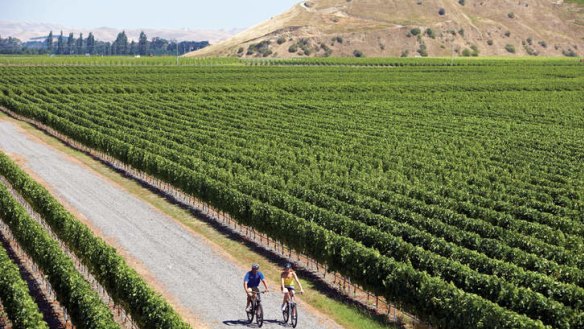New Zealand's glorious reds
There's more to New Zealand wine than sauvignon blanc.

Mention New Zealand wine across the world and one grape variety stands out – sauvignon blanc. It's one of the most fashionable white wines in the world, a wine that excites people far and wide for its penetrating, ripe, pungent varietal character. In the international sauvignon blanc world, New Zealand's version has few peers.
New Zealand reds rate lower in the world's wine consciousness. For many markets Kiwi wine is white, sauvignon blanc the country's crowning achievement, but New Zealand's pinot noir has been establishing itself in many places as something else worth seeking out. The best are superb, and they share with NZ sauvignon blanc a lovely purity and freshness of varietal identity that makes them lovely to sip and savour.
These pinot noirs can be excellent. Their cool heartlands of Martinborough on the North Island with Marlborough and Central Otago on the South, are increasingly well known to pinot lovers across the world, but New Zealand red wine means more than pinot.
Cabernet sauvignon, merlot and syrah (shiraz) can also provide superb New Zealand red wines.
The most famous New Zealand district for grapes other than pinot noir is Hawke's Bay, on the Pacific coast of the North Island. Based around the seaside city of Napier, and its twin city of Hastings a bit further inland, this region of beautiful rolling hills, verdant plains, rivers, art deco architecture and picturesque coastline is one of the few New Zealand wine regions with a continuous history of wine production stretching back to the 19th century, and unlike much of New Zealand's wine country, this place is mostly about medium to full-bodied red wine
Vines came to Hawke's Bay with French Marist missionaries in 1851, and excellent wines were being produced by the late 1800s. Te Mata vineyard was the largest in New Zealand by 1909, but thereafter Hawke's Bay's area under vine shrank as Kiwi wine struggled with public acceptance in a community apathetic to quality table wine. The quality credentials of the region weren't in doubt among those in the know, but in general people who drank wine liked fortifieds, while the non-drinkers in the powerful temperance movement were dedicated to ending consumption of alcohol in all forms. The Great Depression and the First World War had negative impacts, and grape growers found survival in other forms of farming more attuned to community needs at the time. The result was that Hawke's Bay's vineyard area shrank to less than 25 hectares by 1939.
After the Second World War, viticulture in the region continued as before, selling mainly fortified wines with a little table wine on the side. Two of New Zealand's most historic winemaking enterprises struggled on – Mission Vineyards, the original Marist winery, albeit in a different location, and Te Mata Estate, the oldest operating winery in the district. In the 1960s, contract grape growing for table wine kept the region alive, but in the last 40 years a revolution has taken place. The world's thirst for quality has seen this sleepy hollow of Kiwi wine take its rightful place among the world's greats, and now Hawke's Bay is New Zealand's second-largest wine region with nearly 5,000 hectares of vineyard (Marlborough, the largest, has around 16,500 hectares.)
The foundation of modern Hawke's Bay red wine is the “bordeaux blend", a melange of cabernet sauvignon and merlot in varying proportions, perhaps with a smattering of other varieties thrown in. Most of New Zealand is unsuitable to successfully produce these wine styles year in, year out, but the mild climate of Hawke's Bay can ripen cabernet and merlot consistently to make fragrant red wines of lovely elegance, freshness and intensity that mature well in the bottle. Certain subregions have become more prized than others, with the soils known as the Gimblett Gravels particularly sought after as a source of red wines of special concentration and class.
Hawke's Bay's wineries, whether historic properties or new, make up a fair proportion of the who's who of New Zealand's most consistent red wine producers these days. The cabernet blends of Te Mata, Church Road, Sacred Hill, Trinity Hill and Te Awa, to name a few first-class producers, have superb aromatics, concentration and balance with lovely purity of cassis and cedary characters. They wouldn't look out of place in a line-up of top reds from Bordeaux in France, or Australia's Margaret River, and they have considerable ageing potential.
Merlot is planted widely across New Zealand, but few regions do it as well as Hawke's Bay. Names to look for in straight Hawke's Bay merlot or merlot-dominant blends are Craggy Range, Esk Valley, Newton Forrest, Trinity Hill, Church Road and Spy Valley. The best wines are succulent, plummy and seductive, yet concentrated and beautifully balanced with excellent cellaring potential.
These bordeaux-blend reds of Hawke's Bay are great New Zealand wines that can stand comparison to the world's best, but they aren't the only great reds from this part of the North Island. Shiraz, known in New Zealand by its French name syrah, is potentially as great, maybe greater . . . but that's a story for another day.